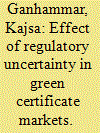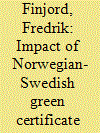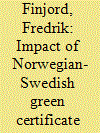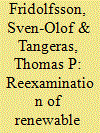|
|
|
Sort Order |
|
|
|
Items / Page
|
|
|
|
|
|
|
| Srl | Item |
| 1 |
ID:
181441


|
|
|
|
|
| Summary/Abstract |
European Commission favours market-based support policies, such as markets for tradable green certificates, to promote renewable energy. Meanwhile, these instruments have received critique for exposing investors to large price risk as the level of support is determined by the market price of certificates. Using a two-step procedure, this study builds upon the work of Fagiani and Hakvoort (2014) by firstly examining how regulatory interventions in the Swedish-Norwegian certificate market affect price volatility, focusing particularly on the period after Norway joined in 2012. The results show that interventions in the market exacerbate price risk by resulting in regimes of increased volatility. They indicate that, contrary to policymakers expectation, prices did not stabilise after the market integration with Norway. Employing a real options approach, the study further proceeds to demonstrate that price risk increases the threshold for immediate development of Swedish wind power projects; a one standard deviation increase in certificate price volatility is estimated to reduce the probability of project development by 12%. These findings illustrate that regulatory uncertainty in terms of high price volatility disrupts the investment climate in certificate markets, ultimately affecting cost-effectiveness of such policy.
|
|
|
|
|
|
|
|
|
|
|
|
|
|
|
|
| 2 |
ID:
162340


|
|
|
|
|
| Summary/Abstract |
In order to encourage investments in the most cost-effective renewable energy projects, Norway and Sweden have implemented a joint green certificate subsidy system, where the certificates are traded on a common market. The policies applied in the two countries, however, are not identical and differ most notably by the deadlines for receiving the subsidy. From the policy perspective, the important question is how these differences affect investment behavior in the renewable sector. This paper investigates the impact of the green certificate subsidy scheme on the value of renewable energy investments from the perspective of both Norwegian and Swedish investors based on a wind energy case study. We find that the impact of the policy is greatest when the distinctive Norwegian investment deadline is approaching, making investment optimal for the Norwegian investor for a larger range of prices. The Swedish investor, having no deadline to meet, will be more reluctant to investing. Furthermore, we find that the possibility of a collapse in the green certificate price reduces the values of the investment options. Being able to learn about the likelihood of such a price collapse leads to a small increase in the values of the options.
|
|
|
|
|
|
|
|
|
|
|
|
|
|
|
|
| 3 |
ID:
162335


|
|
|
|
|
| Summary/Abstract |
In order to encourage investments in the most cost-effective renewable energy projects, Norway and Sweden have implemented a joint green certificate subsidy system, where the certificates are traded on a common market. The policies applied in the two countries, however, are not identical and differ most notably by the deadlines for receiving the subsidy. From the policy perspective, the important question is how these differences affect investment behavior in the renewable sector. This paper investigates the impact of the green certificate subsidy scheme on the value of renewable energy investments from the perspective of both Norwegian and Swedish investors based on a wind energy case study. We find that the impact of the policy is greatest when the distinctive Norwegian investment deadline is approaching, making investment optimal for the Norwegian investor for a larger range of prices. The Swedish investor, having no deadline to meet, will be more reluctant to investing. Furthermore, we find that the possibility of a collapse in the green certificate price reduces the values of the investment options. Being able to learn about the likelihood of such a price collapse leads to a small increase in the values of the options.
|
|
|
|
|
|
|
|
|
|
|
|
|
|
|
|
| 4 |
ID:
132757


|
|
|
|
|
| Publication |
2014.
|
| Summary/Abstract |
In the UK electricity market, generators are obliged to produce part of their electricity with renewable energy resources in accordance with the Renewable Obligation Order. Since 2009 technology banding has been added, meaning that different technologies are rewarded with a different number of certificates. We analyze these two different renewable obligation policies in a mathematical representation of an electricity market with random availabilities of renewable generation outputs and random electricity demand. We also present another, alternative, banding policy. We provide revenue adequate pricing schemes for the three obligation policies. We carry out a simulation study via sampling. A key finding is that the UK banding policy cannot guarantee that the original obligation target is met, hence potentially resulting in more pollution. Our alternative provides a way to make sure that the target is met while supporting less established technologies, but it comes with a significantly higher consumer price. Furthermore, as an undesirable side effect, we observe that a cost reduction in a technology with a high banding (namely offshore wind) leads to more CO2 emissions under the UK banding policy and to higher consumer prices under the alternative banding policy.
|
|
|
|
|
|
|
|
|
|
|
|
|
|
|
|
| 5 |
ID:
111083


|
|
|
|
|
| Publication |
2012.
|
| Summary/Abstract |
Green Certificates are usually described as negotiable instruments or commercial papers. The Italian legal system identifies Green Certificates as rights but, due to the ambiguity of the definition, their juridical nature remains uncertain. This reverberates on the functioning of the Green Certificates market and on the enforcement of the relevant norms. This paper discusses the actual legal nature of Green Certificates in Italy and concludes that they should be regarded as goods. This means that private law instruments apply in their market transactions, with consequent implications on the policy side.
|
|
|
|
|
|
|
|
|
|
|
|
|
|
|
|
| 6 |
ID:
122715


|
|
|
|
|
| Publication |
2013.
|
| Summary/Abstract |
Green certificates are the main instrument for promoting renewable electricity (RES-E) in Sweden. But certificates cover only a limited share of total RES-E production. Under partial coverage, crowding out may arise whereby costly new RES-E replaces inexpensive old RES-E. Granting certificates to all of RES-E production improves efficiency, but leaves windfall rent to otherwise profitable facilities. We also analyze transaction costs in the permit process for new RES-E in Sweden. Municipalities veto socially desirable projects because of asymmetrically distributed investment costs and benefits. We propose market-based permit fees rather than limited veto rights as a solution to this NIMBY problem.
|
|
|
|
|
|
|
|
|
|
|
|
|
|
|
|
| 7 |
ID:
150345


|
|
|
|
|
| Summary/Abstract |
We analyse the joint problem of supporting renewables and resource adequacy in a liberalised electricity market and present a detailed model-based comparison of two alternative policies. We undertake this in the context of the British market. We show how, ceteris paribus, the progressive replacement of coal with wind imposes extra costs of reserve and evaluate alternative way to meet this, whether through capacity payments funded by customers, or a reliability requirement on wind generators with capital cost or energy feed-in subsidies. We consider the reality of market concentration and the extent to which pragmatic regulation could allow prices to rise above marginal cost to reduce the extent of direct subsidies and complex market designs. We also evaluate the implied cost of carbon reduction in a progressive replacement of coal with wind, when the security is maintained by extra peaking gas. We find that support through capital allowances rather than the energy market is more efficient.
|
|
|
|
|
|
|
|
|
|
|
|
|
|
|
|
|
|
|
|
|